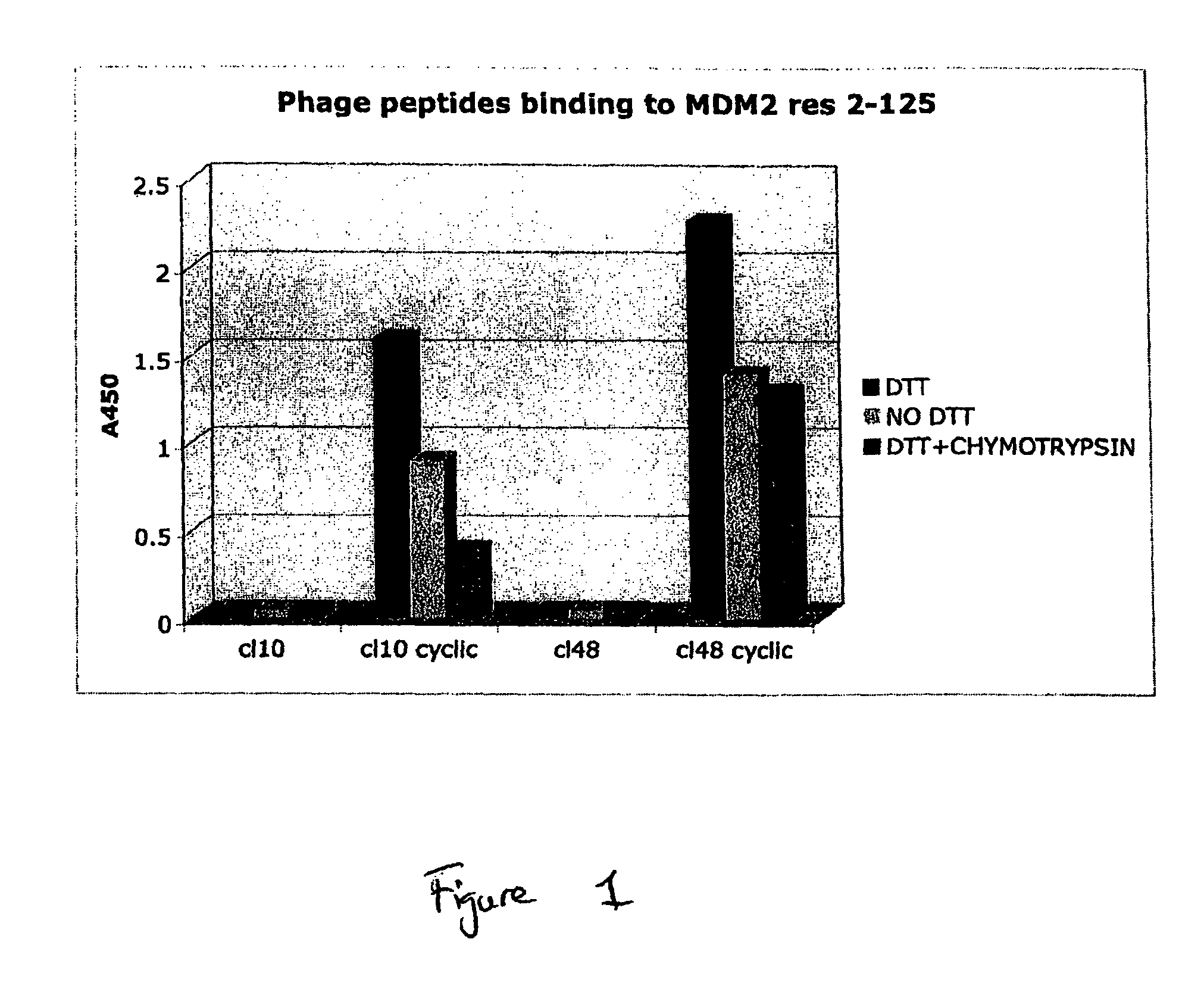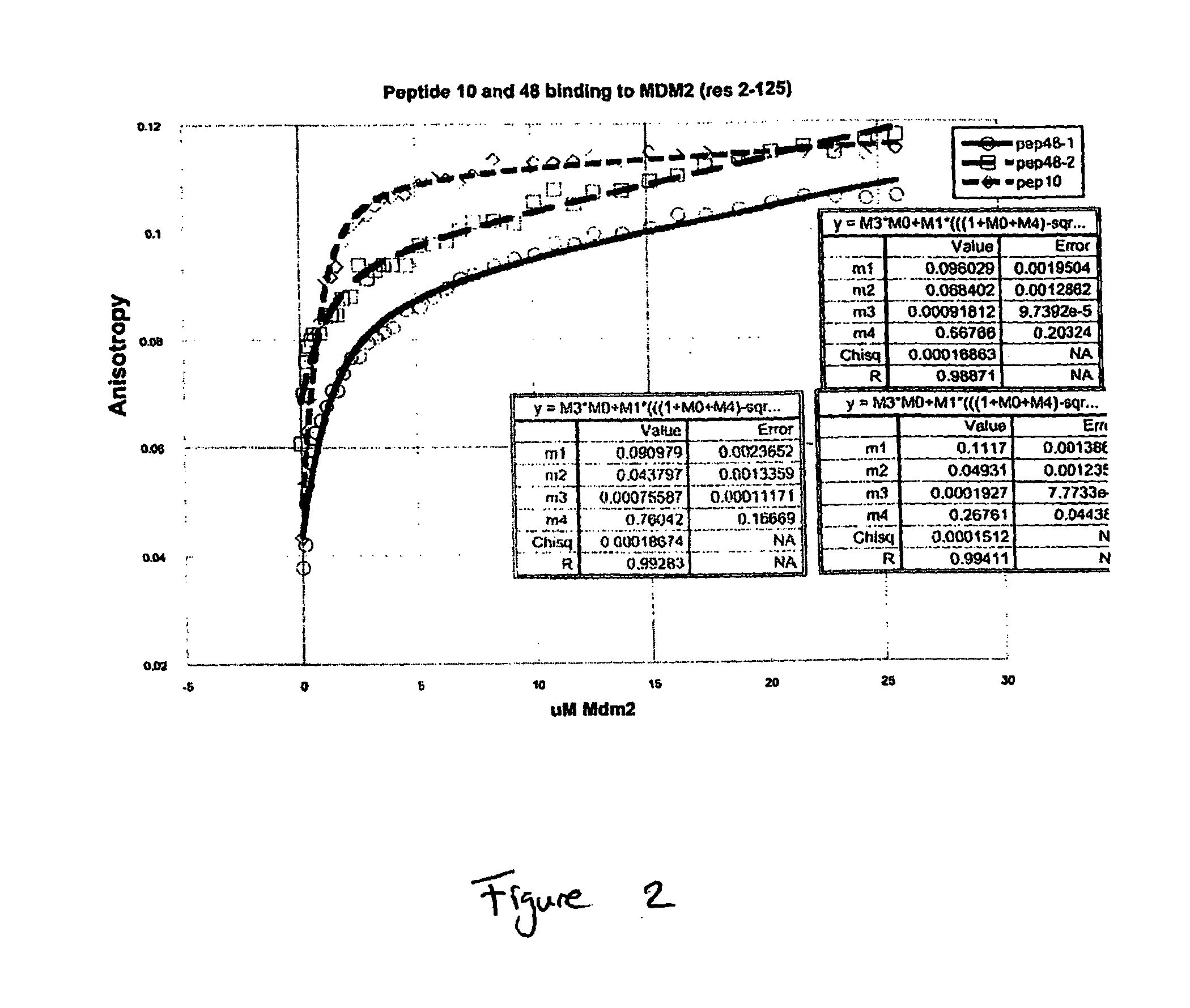Structured Peptide Processing
- Summary
- Abstract
- Description
- Claims
- Application Information
AI Technical Summary
Benefits of technology
Problems solved by technology
Method used
Image
Examples
example 1
Protease Resistant Bicyclic Peptides Against MDM2
[0133]MDM2 is an enzyme (an E3 ubiquitin ligase) that recognises the trans-activation domain of p53, the tumour suppressor, leading to ubiquitinylation and degradation of p53 by the proteosome. A nutlin inhibitor of the p53-MDM2 interaction can lead to in vivo activation of the p53 pathway, and it has been suggested that such agents may have potential as anti-cancer agents. Here we describe the selection of two bicyclic peptides (PEP10 and PEP48) against MDM2, a target “antigen”. The affinity of each synthetic peptide was sub-micromolar, and in the range 250-750 nM. At least one of the peptides was shown by competition ELISA to bind to the same site as a linear peptide previously shown to block the p53-MDM2 interaction.
[0134]Protocols generally followed those described earlier in Heinis et al., 2009, Nature Chemical Biology 5, 502-507, unless otherwise indicated. In the work of Heinis et al., both targets, kallikrein and cathepsin G, ...
example 2
Protease Resistance of Bicyclic Peptides
[0172]The bicyclic peptides PK15 and CG4 of Heinis et al., 2009, were selected against the proteases kallikrein and cathepsin G respectively, and it would not be surprising if the bicyclic peptides are resistant to digestion by these proteases, particularly the constrained nature of the scaffold should help protect against proteolytic attack.
[0173]We compared PK15 linear (cysteines treated with iodoacetamide) with PK15 conjugated to the TBMB scaffold, with kallikrein and with other proteases, see Table below (the scale ranges from +++ (substantially intact) to − (completely cleaved). As expected the PK15 conjugate with TBMB was more resistant than the linear to attack by kallikrein. The factor was about 100 fold, as shown by comparing different concentrations of enzyme.
[0174]For the other proteases, the factor ranged between 10 and 100 fold, depending on the protease. We also compared the resistance of the bicyclic CG4L1-PK15L1 (WO 2009 / 098450...
example 3
Trypsin and Chymotrypsin Cleavage Sites of PK15
[0177]To identify the trypsin and chymotrypsin cleavage sites of PK15, we used both the iodoacetamide-derivatized peptide and the TBMB conjugate, as described above in Example 2. The proteolysis conditions were also as described in Example 2. By mass spectrometric analysis, from analysis of the molecular masses of the cleaved species, we were able to show that in the iodoacetamide derivatized peptide (AC*SDRFRNC*PADEALC*G) R7 and R9 were both cleaved by trypsin, and F8 cleaved by chymotrypsin. The same cleavage sites were seen in the TBMB conjugated peptide, except that the cleavages were at a much slower rate as noted in Example 2. Furthermore with trypsin, the initial cleavage step was at R7, followed in longer incubations by cleavage at R9.
Methods
[0178]Peptides and conjugates were purified on a Proteo C12 (4μ, Phenomenex) column using a Varian 940 HPLC. Buffers used were 0.1% TFA (A) and 90% MeCN, 0.1% TFA (B). Generally samples were...
PUM
| Property | Measurement | Unit |
|---|---|---|
| molecular weight | aaaaa | aaaaa |
| octanol-water partition coefficient log P | aaaaa | aaaaa |
| pH | aaaaa | aaaaa |
Abstract
Description
Claims
Application Information
 Login to View More
Login to View More - R&D
- Intellectual Property
- Life Sciences
- Materials
- Tech Scout
- Unparalleled Data Quality
- Higher Quality Content
- 60% Fewer Hallucinations
Browse by: Latest US Patents, China's latest patents, Technical Efficacy Thesaurus, Application Domain, Technology Topic, Popular Technical Reports.
© 2025 PatSnap. All rights reserved.Legal|Privacy policy|Modern Slavery Act Transparency Statement|Sitemap|About US| Contact US: help@patsnap.com


